The week at a glance
- Western Orphean Warbler in Pembrokeshire
- Short-billed Dowitcher identified on North Ronaldsay
- Pacific Diver again in Cornwall
- Brief Yellow-breasted Bunting in Norfolk
- Lesser Grey Shrike in Northumberland
- Continuing influx of Parrot and Two-barred Crossbills
Just when we were beginning to believe that the remarkable autumn of 2013 might finally be over, the birding world sprung a fresh batch of surprises, reminding us that the middle of November can never be dismissed — even when weather conditions are less than ideal, as they have been this week.
The clear highlight for many was a Western Orphean Warbler in Peter and Rosemary Royle's garden, a stone's throw from St Brides (Pembrokeshire). Though first seen as long ago as Sunday 10th, the bird's identification was only realised — as an 'Orphean Warbler' at least — when photographs were posted on the Pembrokeshire Birds blog. Peter and Rosemary very kindly agreed to open up their garden to prospective twitchers between the Friday and Sunday, with a voluntary team of local birders helping to organize and marshal in quite exemplary fashion — somewhat akin to the last big Welsh twitch for the Common Yellowthroat in Gwent in early 2012. The bird performed well to all comers over the weekend, and excellent photographs of the bird's key feature — the outer tail feathers — clinched its identification as hortensis. If it is still present on Saturday, further access to the garden has been planned for this coming Sunday (24th); watch Bird News Extra for access details.

Western Orphean Warbler, St Brides, Pembrokeshire (Photo: David Astins)
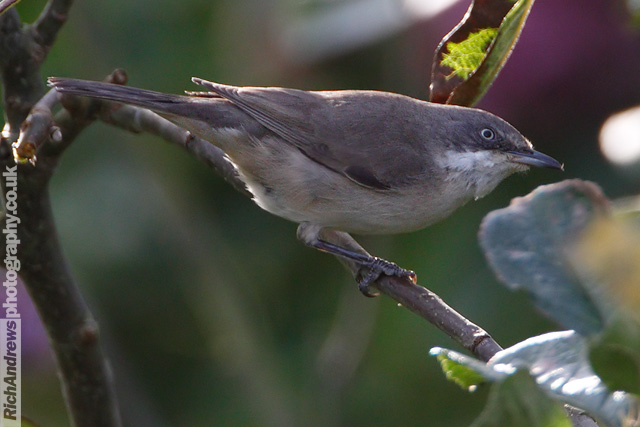
Western Orphean Warbler, St Brides, Pembrokeshire (Photo: Rich Andrews)
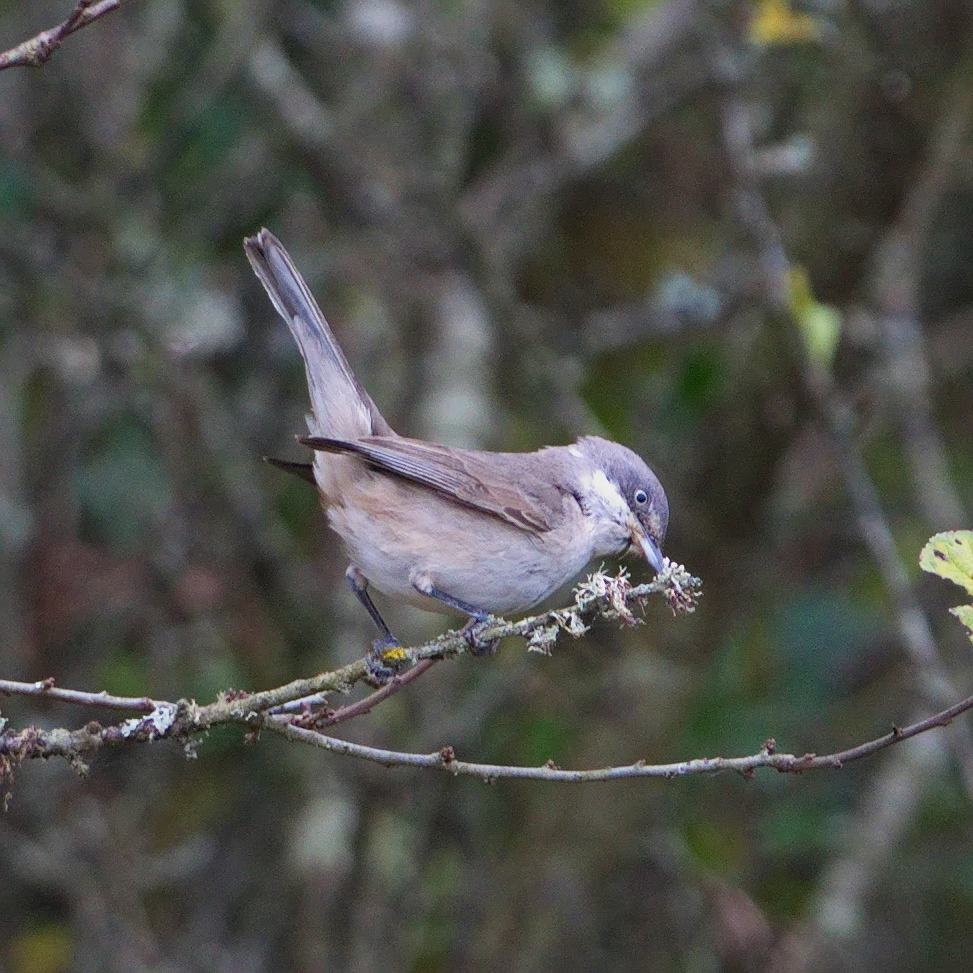
Western Orphean Warbler, St Brides, Pembrokeshire (Photo: Paul Rowe)
Western Orphean Warbler, St Brides, Pembrokeshire (Video: Pete Hines)
With all eyes on south-west Wales throughout the week, the fantastic discovery of a first-winter Short-billed Dowitcher on North Ronaldsay (Orkney) on 17th undeservedly almost passed under the radar. Still present on 20th, the bird, now largely in winter dress, has also been heard to call on several occasions. A first for Orkney, one can only imagine how popular it might have been had it not been for last year's long-staying birds in Dorset and on Scilly.
Down in the south-west, belated news came to light of a first-winter female Dusky Thrush present in Brixham (Devon) between 26th October and 2nd November. Once again, the contentious issue of suppression has been discussed at length in many corners of the Internet, so nothing more will be said here. On a more positive note, the bird was well documented and, of interest to those who saw the Kent bird in May, looks reasonably similar to the Margate individual. One wonders how bleached and worn the Brixham bird might look in six months' time.

Dusky Thrush, Brixham, Devon (Photo: Josh Marshall)
Dusky Thrush, Brixham, Devon (Video: 'Dusky Thrush Devon')
Dusky Thrush, Margate cemetery, Kent (Video: Paul Wetton)
Cornwall welcomed back what is presumably the returning Pacific Diver on Saturday, discovered among a flock of Black-throated Divers in Gerrans Bay off Pendower Beach that morning. It was still present there on 19th, and was even well photographed, which hasn't happened in past winters.
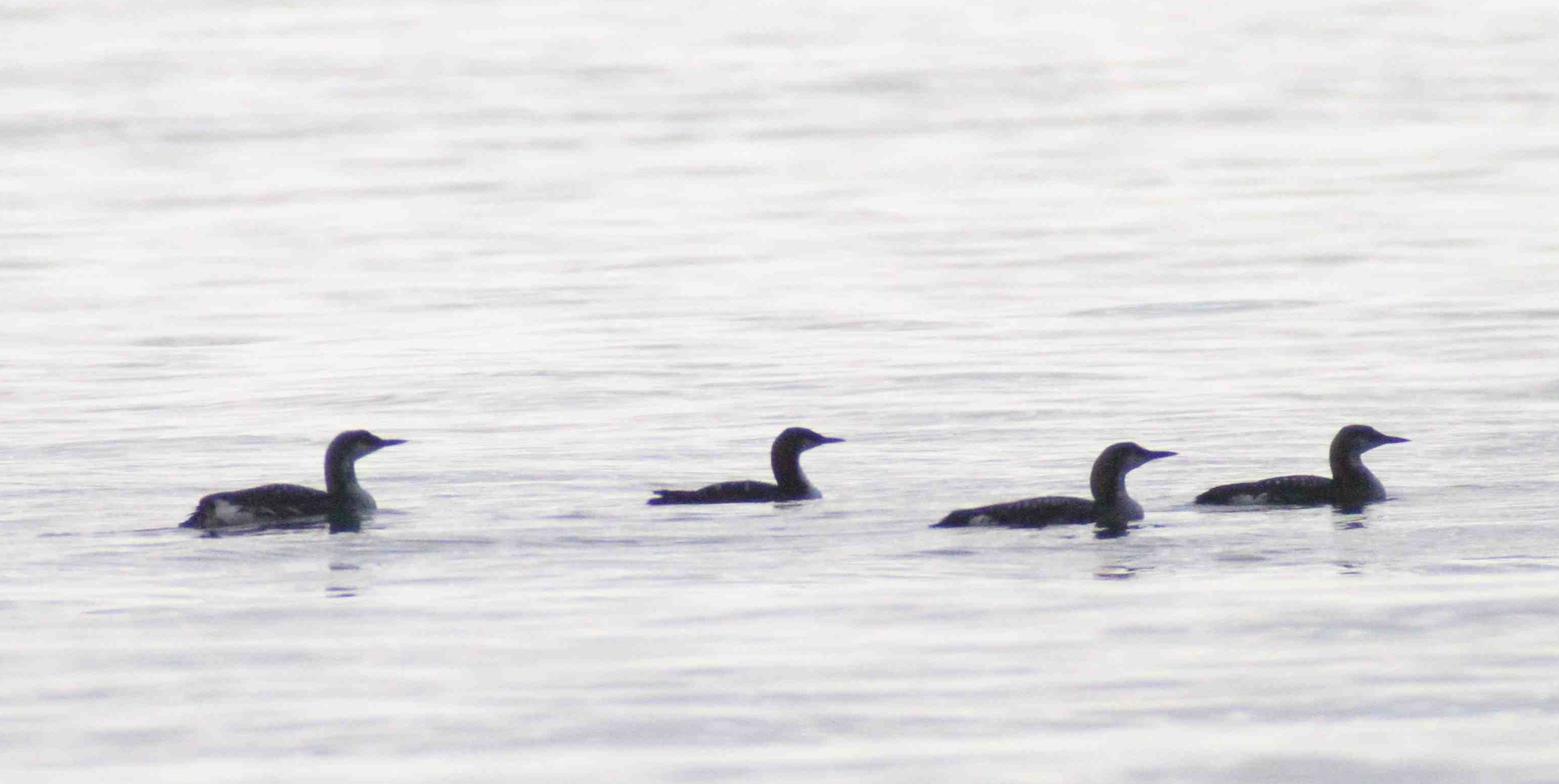
Pacific Diver, Pendower Beach, Cornwall (Photo: Stuart Bearhop)
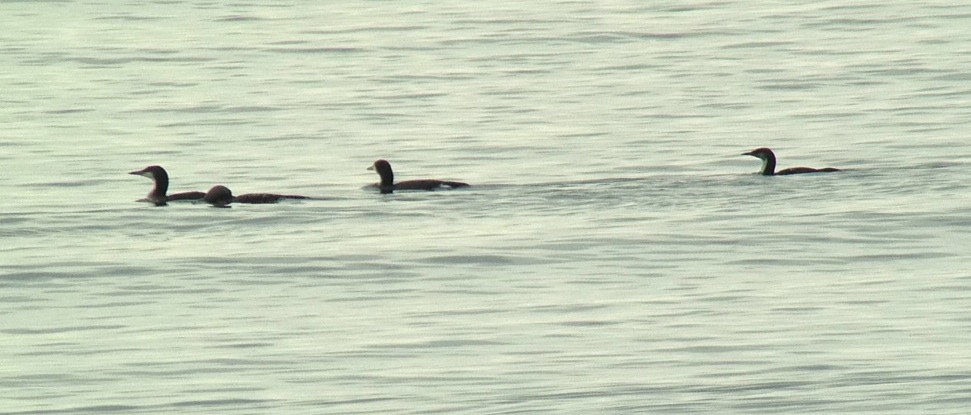
Pacific Diver, Pendower Beach, Cornwall (Photo: Steve Votier)
Two further highlights emanated from the 'Cley square'. Firstly, the apparent juvenile Thayer's Gull was reported again on the reserve early morning on 14th before flying off, never to return. Secondly, late on 18th, a Yellow-breasted Bunting was seen briefly by the Lifeboat Station at the end of Blakeney Point. There was, however, no sign the next morning and the long wait for another twitchable example of this rapidly declining species continues. Further disappointment followed an initial report of a Snowy Owl on the golf course at Felixstowe Ferry (Suffolk) on 19th — there was no further sign by dusk and, later that evening, it transpired that a bird had escaped in the Felixstowe area recently.
With increasing numbers of birders turning their attention to our woodlands, it was perhaps no great surprise that further Two-barred and Parrot Crossbills were discovered this week. What was surprising, though, was the sheer number of Two-barreds found in the Forest of Dean on Saturday: after an initial report of five near Kensley Lodge early morning, numbers built throughout the day to an extraordinary peak of 17 by early afternoon! Though numbers didn't quite climb that high subsequently, 14 were reported on 17th and at least nine still on 18th. One wonders how many more must be out there, waiting to be discovered — further birds remained in South Yorkshire, Norfolk, Surrey and Kent. As for Parrots, up to a dozen remained at Holt Country Park (Norfolk) throughout the week, while at least one new bird was discovered in the New Forest at Slufer's Inclosure (Hants) on 19th. Two were also still in Hemsted Forest (Kent).
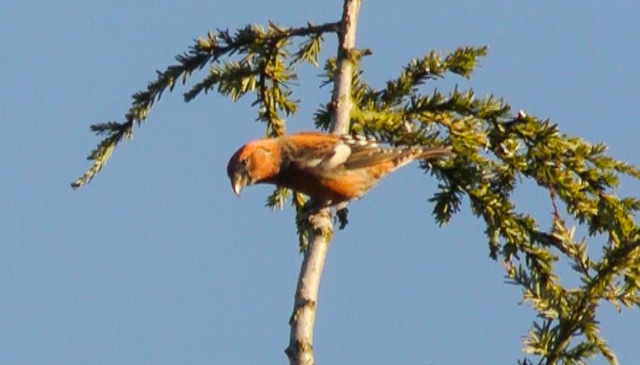
Two-barred Crossbill, Crabtree Hill, Gloucestershire (Photo: Mark Hipkin)

Parrot Crossbill, Holt, Norfolk (Photo: Carole Fox)

Parrot Crossbill, Holt, Norfolk (Photo: Harry Murphy)

Parrot Crossbill, Hemsted Forest, Kent (Photo: Tony Marchese)

Parrot Crossbill (left), Common Crossbill (centre) and Two-barred Crossbill (right), Hemsted Forest, Kent (Photo: Alan Pavey)
This week's line-up of rare geese was almost an exact re-run of the previous week's, with the first-winter Ross's Goose still at Marshside (Lancs) to 17th, the possible Grey-bellied Brant still at Bull Island (Dublin), a Richardson's Canada Goose on Islay (Argyll) on 18th and the Red-breasted Goose still showing well in Hampshire. Black Brants were reported in Norfolk, Essex, Hampshire, Dorset and Devon, while the two blue-morph Snow Geese were still at Loch of Skene (Aberdeenshire) on 15th and the white morph was still at Carrahane Strand (Kerry) on 19th.
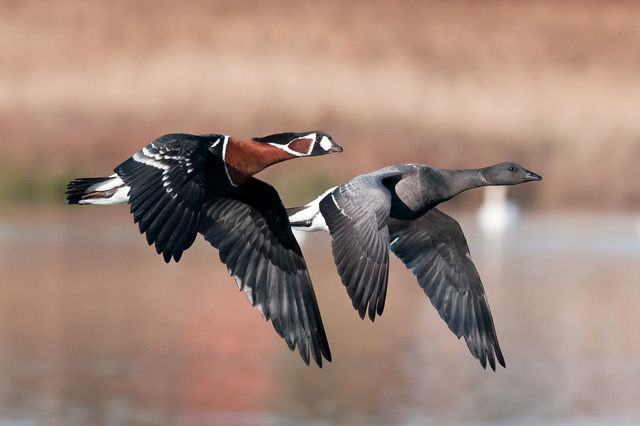
Red-breasted Goose, Sturt Pond, Hampshire (Photo: Jason Crook)

Black Brant, Hayling Island, Hampshire (Photo: Gary Loader)
What is presumably last winter's drake Lesser Scaup was again at Lough Gill (Kerry) from 15th, with the young female still in County Galway and the drake still at Chew Valley Lake (Somerset). A drake Ferruginous Duck was also at Chew on 16th, and a new female was at Dungeness (Kent) the same day. The only British Ring-necked Ducks reported were females: at Stanwick Gravel Pits (Northants) on 20th and the long-stayer still at Eyebrook Reservoir (Leics) on 18th, while a drake was at Lough Ea (Donegal) on 20th. Just two American Wigeon comprised drakes still in Highland and Aberdeenshire. The Blue-winged Teal was last reported at Boultham Mere (Lincs) on 14th, though five new Green-winged Teal were located: on North Ronaldsay on 15th, at Loch of Kinnordy (Perth/Kinross) on 17th, Portworthy Dam (Devon) on 17th–18th and at Nunnery Lakes, Thetford (Norfolk) and Shannon Airport Lagoon (Clare) on 20th, in addition to birds still in Dumfries & Galloway and at Rutland Water.
In County Mayo, Achill Island's two long-staying heavyweights were again reported on 14th: the Black Duck on Sruhill Lough, and the Pied-billed Grebe across the island on Sruhillbeg Lough. Two White-billed Divers were in Bluemull Sound (Shetland) on 14th (one on 20th) and a second-winter drake King Eider was off Fetlar on 20th, though the drake in Burghead Bay (Moray/Nairn) was not seen after 15th. A strong week for Surf Scoter records saw several new birds found: female/immatures were off Black Rock Strands (Gwynedd) on 15th, Worthing (W Sussex) on 18th and Kinvarra (Galway) on 19th, and drakes were off Shell Island (Gwynedd) and The Wig (Dumfries & Galloway) on 17th — the latter is presumably last winter's bird returning. Furthermore, lingering birds continued in Counties Waterford and Cork, Dorset, Conwy (2) and the Outer Hebrides.
Cattle Egret records were again limited to Kent: at least two birds appear to be touring the county, with the long-staying Sheppey bird still there on 17th and another again at Grove Ferry on 17th–19th. A third flew over Margate Cemetery on 19th. Around 20 Great White Egrets were reported during the week, with threes on the Ince Marshes (Cheshire) and at Pitsford Reservoir (Northants). Several Glossy Ibis remained, although they were not as commonplace as in previous weeks. Birds were reported from Kent (2), Essex, Norfolk, Cambridgeshire, Nottinghamshire and Gloucestershire (2).

Great White Egret, Catcott Lows NR, Somerset & Bristol (Photo: James Gibbs)
The Northern Harrier was reported again from Tacumshin (Wexford) on 16th, and the Ouse Washes bird was seen at nearby Welney (Norfolk) on 15th. The white-morph Gyr Falcon reappeared at Balemore, North Uist on 17th and the Rough-legged Buzzard was still at Orford Ness (Suffolk) on 17th. The Black Kite also continued to tour the far south-east, being seen at Rye Harbour (E Sussex) on 14th–15th, again at Dungeness on 16th–17th, and then at Brookland on 17th and Hamstreet on 18th. If pinned down, given the time of year it would be interesting to see whether this appears to be a candidate for lineatus (Black-eared Kite).
Late American Golden Plovers were found at Ballycotton (Cork) on 16th–17th and Sennen (Cornwall) on 17th–18th, and the adult White-rumped Sandpiper remained at Frampton Marsh (Lincs) to 19th at least. Meanwhile, Hampshire held on to the Lesser Yellowlegs at Lepe Country Park and the Long-billed Dowitcher at Keyhaven Marshes — both look set to winter. One or two Grey Phalaropes remained scattered around, and a Spotted Crake was also reported again from Arundel (W Sussex) on 17th.
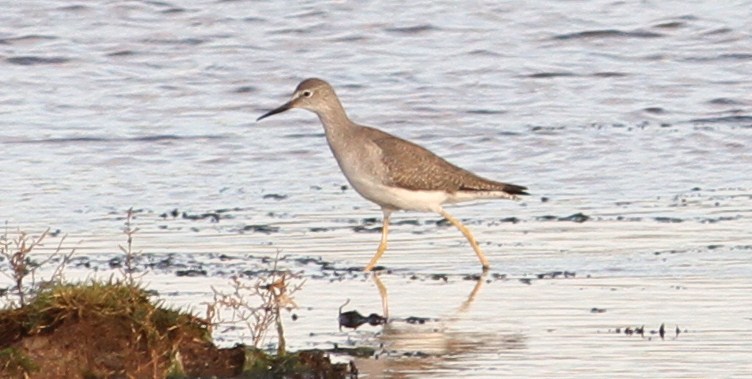
Lesser Yellowlegs, Lepe CP, Hampshire (Photo: Neil Cowley)

Grey Phalarope, Carnoustie, Angus & Dundee (Photo: Barry Farquharson)
The adult Bonaparte's Gull was still at Dawlish Warren (Devon) to 18th and the mobile Northumberland bird was seen at Bamburgh on 16th and then off the Farne Islands on 18th. A first-winter Ring-billed Gull was found inland at Killarney (Kerry) on 19th, and a second-winter was in Liverpool on 20th. A possible first-winter roosted at Belvide Reservoir (Staffs) on 16th, while long-stayers were still in Hampshire and Counties Kerry and Galway.

Ring-billed Gull, Killarney, Kerry (Photo: Davey Farrar)
A particularly late Golden Oriole was an utterly unexpected find near the Comber Estuary (Down) on 15th, and was well photographed. Similarly late was a Wryneck at Sennen Cove (Cornwall) on 17th. Perhaps as many as ten Richard's Pipits included a remarkable report of up to five at Winterton Dunes (Norfolk) on 19th; lingering birds were at Portland (Dorset) on 14th–15th and Egypt Bay (Kent) on 16th–19th. The Siberian Stonechat was still on Westray (Orkney) on 16th, with another on St Agnes (Scilly) from 17th–20th. For many people the quintessential late-autumn vagrant, a smart male Desert Wheatear at Pembroke Bay (Guernsey) on 18th–19th was a timely reminder that mainland Britain is yet to host one this year. Meanwhile, Barred Warblers remained at Spurn (E Yorks) and Fethard-on-Sea (Wexford).

Richard's Pipit, Portland, Dorset (Photo: Joe Stockwell)

Desert Wheatear, L'Ancresse Common, Guernsey (Photo: Adrian Gidney)
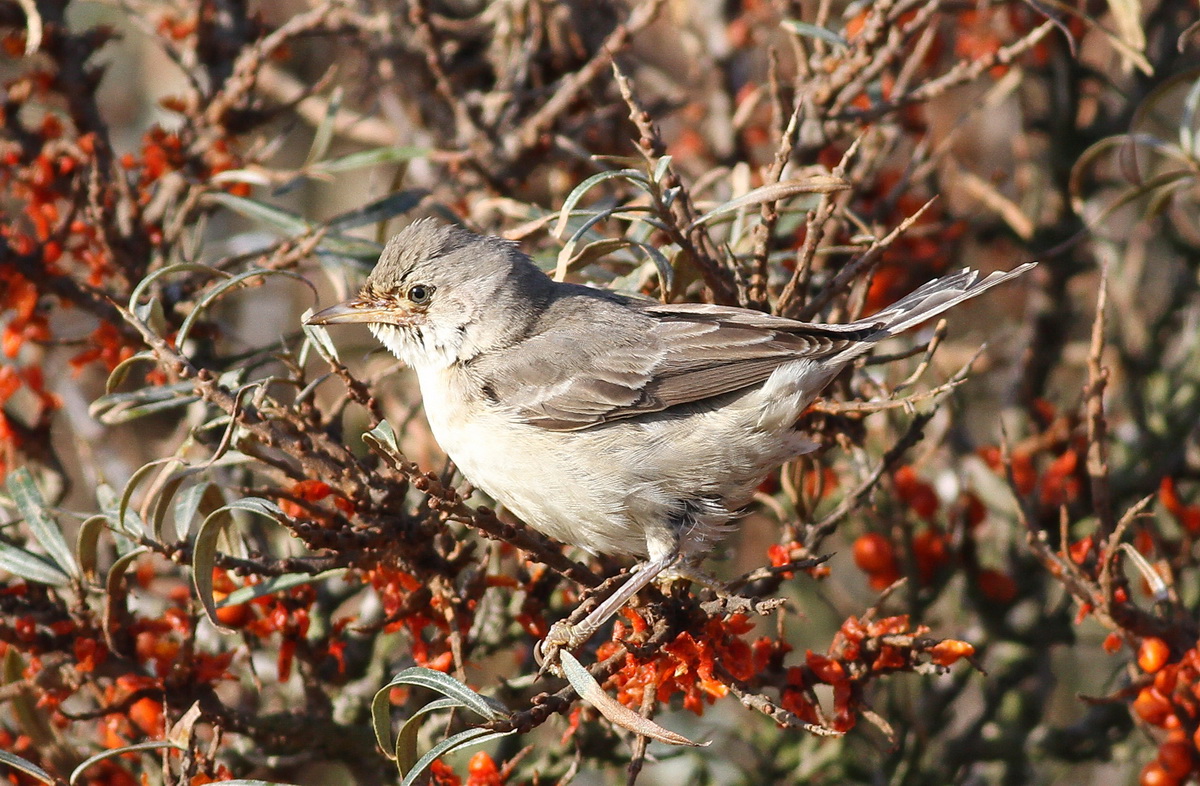
Barred Warbler, Spurn YWT, East Yorkshire (Photo: Richard Willison)
Up to twenty Great Grey Shrikes showed a somewhat typical winter pattern, with all records stemming from the southern half of England and Wales. One wonders how many must go undetected in the wilds of Scotland, where suitable habitat is really quite commonplace.

Distribution of Great Grey Shrike records in the week ending 20th November 2013.
One of the big surprises of the week was a Lesser Grey Shrike at the Long Nanny (Northumberland). First reported on 15th as a Great Grey, it was reidentified that afternoon and lingered until the week's end. A Red-backed Shrike was on St Agnes (Scilly) on 15th. A new Red-breasted Flycatcher was found on the fence by the Eye Field at Cley Marshes (Norfolk) on 16th, and last week's bird was reported again on the Pevensey Levels (W Sussex) on 14th. The Rose-coloured Starling remained at Caister-on-Sea (Norfolk) all week, as did the Serin at Flamborough (E Yorks) — further flyovers of the latter species were logged on St Agnes (Scilly) on 16th and at Knapwell (Cambs) on 18th.

Lesser Grey Shrike, Long Nanny, Northumberland (Photo: Colin Bradshaw)
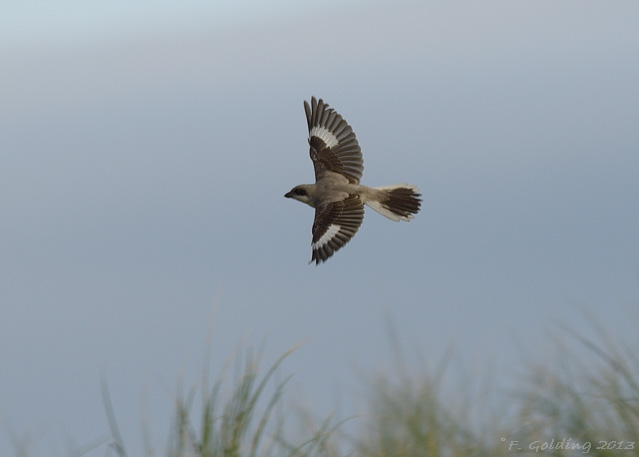
Lesser Grey Shrike, Beadnell Bay, Northumberland (Photo: Frank Golding)

Red-breasted Flycatcher, Cley Marshes NWT, Norfolk (Photo: Gilly)
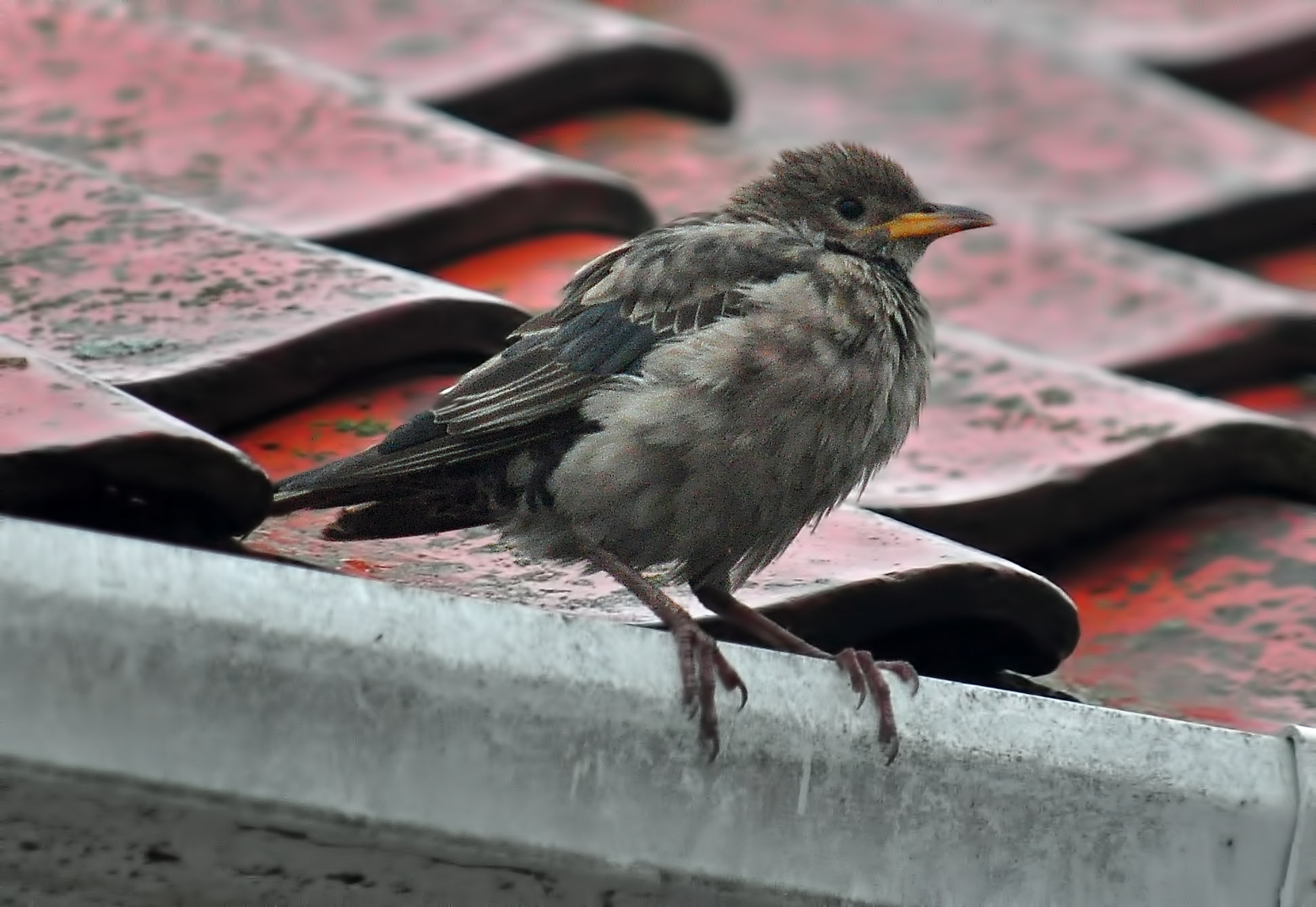
Rose-coloured Starling, Caister-on-Sea, Norfolk (Photo: Jack Bucknall)

Serin, Flamborough, East Yorkshire (Photo: Dave Kelsall)
Photo of the Week
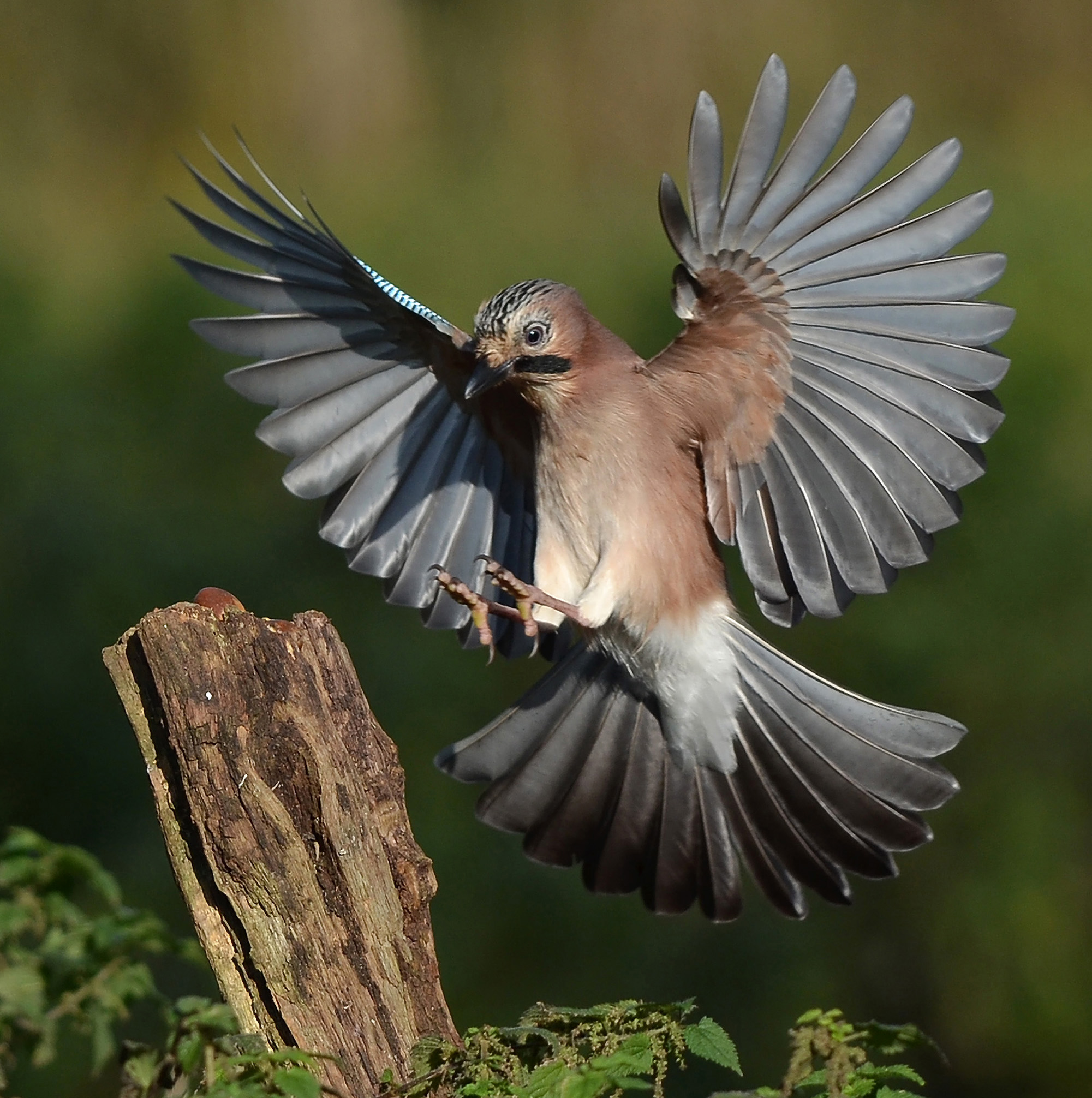
Jay, undisclosed site, Norfolk (Photo: Matt Crosby)
Many bird photographers shy away from bird-in-flight ('BIF') photography, but a look through Matt Crosby's submissions to BirdGuides shows he definitely isn't one of them. Matt has had a go at a wide range of flying birds and seems to have a particular interest in landing shots. It is also apparent that Matt has a penchant for Jays and has been trying for a Jay landing shot for some time. This week, he certainly succeeded in this mission with an exquisite action image of a Jay in its last millisecond before alighting on a stump. The fully fanned wings and tail show how birds achieve maximum deceleration ready for landing. Extended feet and intense concentration complete the bird's preparation. Great lighting, woodland colours and thoughtful composition round off an image with both impact and appeal.
Other notable images

Snow Bunting, Northam Burrows CP, Devon (Photo: Rob Cross)

Gannet, Hermaness NNR, Unst, Shetland (Photo: Robbie Brookes)

Barn Owl, Lakenheath (Hockwold) Fen, Suffolk (Photo: Neil Rolph)

Desert Wheatear, L'Ancresse Common, Guernsey (Photo: Adrian Gidney)
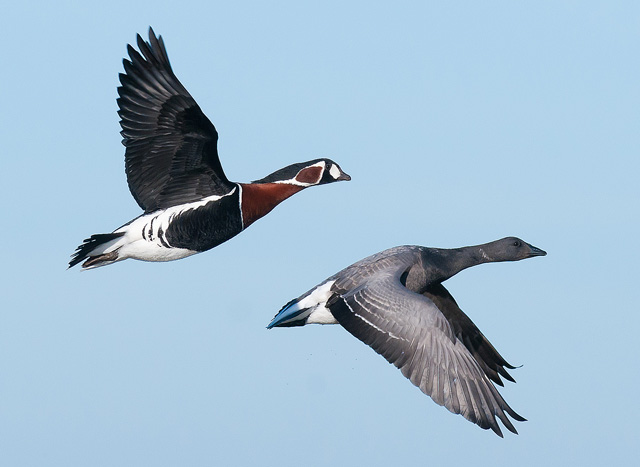
Red-breasted Goose, Sturt Pond, Hampshire (Photo: Jason Crook)

Bullfinch, Redditch, Worcestershire (Photo: Mr Clive Daelman)

Red Grouse, undisclosed site, West Yorkshire (Photo: Mike McKenzie)
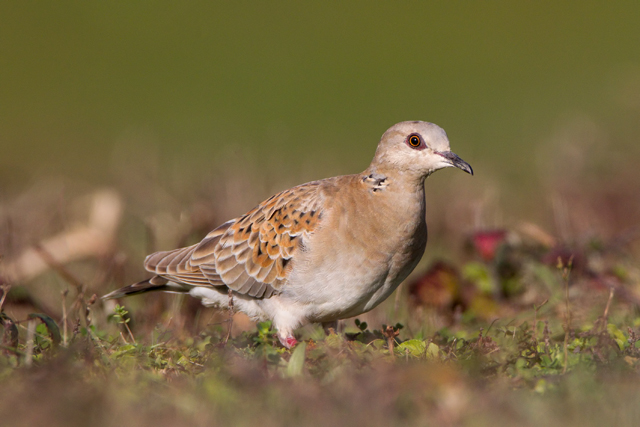
Turtle Dove, Cosmeston Lakes CP, Glamorgan (Photo: Chris Sandys)
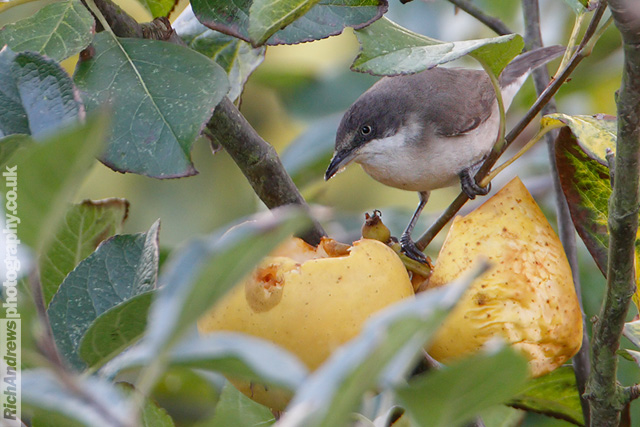
Western Orphean Warbler, St. Brides, Pembrokeshire (Photo: Rich Andrews)


